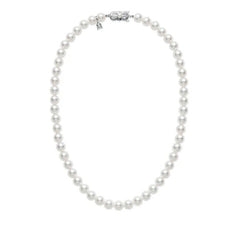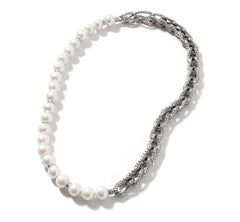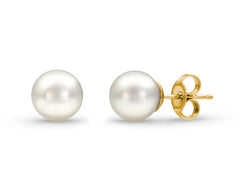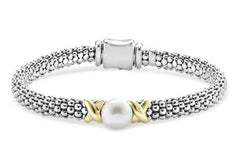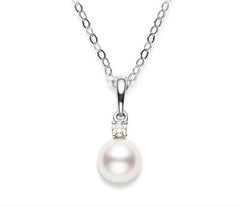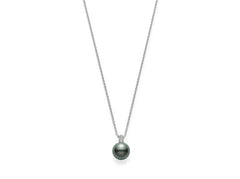If there is one type of jewelry every woman should own, it’s a set of pearls. Nothing is as satisfying as opening your jewelry box to see the classic collection of pearl necklaces, pearl earrings, and pearl bracelets waiting to be paired with any outfit.
Pearls can be either traditional or modern, depending on how you style them. A variety of pearl colors and settings allows you to incorporate these lustrous gems into any aesthetic. With a unique origin story and beautiful product, it is easy to see why pearls are treasured.
The History of Pearl Jewelry
Pearls have been used in jewelry for centuries. The people of ancient Greece believed pearls were the tears of the gods, and the oldest-known pearl jewelry was buried with a Persian princess in 520 BC. Pearl jewelry was a symbol of status, with only the wealthiest people in society able to afford it.
Pearl jewelry became more affordable in the early 1900s when culturing saltwater pearls started in Asia. Since jewelry makers were no longer relying on naturally occurring pearls, the gems have become more accessible and, therefore, more economical to own.
Even though classic pearl necklaces and simple pearl earrings are timeless, jewelers have also been able to bring a modern twist to pearl jewelry. Even the most contemporary woman can embrace pearls by layering pearl jewelry with other pieces or sporting unique pearl colors.
Giving Pearls as Gifts
There are many occasions when pearl jewelry would be an ideal gift. Whether it’s pearl necklaces or pearl bracelets, the meaning behind pearls can be sentimental and sweet. In fact, pearls are the perfect gift to celebrate a 30th anniversary with your loved one.
If someone you care about was born in June, you might surprise them with pearl earrings or a pearl bracelet to celebrate with their birthstone. Whether you take a traditional approach with simple pearl necklaces or find different pearl colors to stand out, you will impress the birthday girl with pearls.
How are Pearls Formed?
Pearls are a wonder of nature, proving in a very real way that something irritating can become something beautiful. They are formed when a foreign substance, like a grain of sand, makes its way into a mollusk’s shell. The creature’s natural defense is to cover the substance with layers of fluid called nacre, which results in a beautiful pearl. While this process happens naturally, the creation of the gem takes five to ten years.
Pearl colors vary by the type of mollusk used to produce the gem. For example, Tahitian pearls often get their dark color from Tahitian pearl oysters, which have black lips. Because pearl colors vary, it is easy to find a variety of looks with pearl jewelry.
The 3 Types of Pearls
For centuries, pearls were costly because they were not easy to find. Now, pearls are more accessible because humans have figured out how to start the pearl-making process in a controlled setting. Because of this, there are three primary types of pearls:
Type 1 - Natural Pearls
Natural pearls are still the most expensive pearls on the market. Formed organically in nature, natural pearls are extremely rare and hard to find. Natural Pearls occur without any intervention from mankind, and it is estimated that only 1 in every 10,000 wild oysters will produce a pearl.
Type 2 - Cultured Pearls
If you buy pearl jewelry today, you are likely purchasing cultured pearls. Started in the late 19th century, culturing has produced pearls the same way natural pearls are made, but humans help get it started by surgically placing the irritant inside the oyster.
While humans get the ball rolling, it is still up to nature to produce a gem fit for luxury jewelry. Overall, the look and quality of a cultured pearl is the same as a natural pearl. Because cultured pearls are made in a controlled environment, the oyster survival rate is higher and more pearls are recovered, making cultured pearls more affordable.
Mikimoto: The Inventor of Cultured Pearls
Kokichi Mikimoto invented cultured pearls in 1893, and since then, his name has been associated with class and elegance. A striking designer pearl necklace from Mikimoto is perfect for dressing up or going casual, making it an essential addition to any jewelry box.
Type 3 - Imitation Pearls
Like with any gem, it is best to buy your pearl jewelry from a reputable jeweler to avoid imitation pearls. These pearls are not made in oysters at all but instead are made from glass beads that are dipped into a fish-scale solution. Many seem convincing and initially have a high luster, but that will fade over time.
You can test whether your pearls are real or fake by rubbing two together. If they slide across each other with ease, they are likely glass. Cultured or natural pearls feel gritty because of the layers of nacre used to make them.
Popular Pearl Jewelry
Whether you are giving a gift or looking for a piece of jewelry for yourself, pearls are a classic option. While some may associate pearl jewelry with old-fashioned style, pearls are also perfect for modern women. An environmentally-friendly jewelry option, pearls are versatile and desirable.
Not only are pearls easy to dress up or down, but they also fit almost any jewelry setting. Pearl bracelets, pearl earrings, and pearl necklaces are all beautiful staples for women around the world.
Pearl Necklaces
There is nothing chicer than pearl necklaces. From a string of pearls to pearl pendants and everything in between, the versatility and elegance of pearls shine when looking at pearl necklaces. Whether going shopping, going to work, or going out on the town, there is a pearl necklace for every occasion.
Consider your shirt or dress’s neckline when putting together an outfit with pearl necklaces. A simple strand of pearls would look best with a V-neck, strapless top, scoop, or button-down neckline. Pearl necklaces with pendants pair well with a V-neck, square, strapless, or plunging neckline.
Pearl necklaces don’t have to be a standard pendant or string of pearls. A statement necklace mixing pearls with other patterns or materials is the perfect way to marry pearls to a modern look.
Pearl Earrings
Pearl earrings are a necessary item in every woman’s jewelry collection. Classic stud pearl earrings go with any outfit and easily add a finishing touch to your ensemble, but they aren’t the only option.
Of course, there is no need to limit yourself to the staple pieces. Finding pearl earrings with different shapes and pearl colors — like a pair of pearl drop earrings featuring Black South Sea pearls and diamonds — can add intrigue and sophistication.
Pearl Bracelets
As with many stunning bracelets, pearl bracelets are great to stack or wear alone. It is easy to mix pearl colors when stacking bracelets to create a unique look for your day. Some pearl bracelets feature a single pearl while other pearl bracelets resemble a classic strand of pearls.
Pearl bracelets can bring a whole outfit together when paired with pearl necklaces and pearl earrings. Having a matching set of pearl jewelry — or similar sets with different pearl colors — helps any woman look sophisticated and ready for anything the day may bring her.
5 Primary Pearl Quality Factors
When purchasing pearl jewelry, you want to know you are getting a quality piece that will stand the test of time. Ensuring your pearls are up to your standards will give you confidence in your jewelry.
Several factors come into play when purchasing pearl jewelry. While there is no industry-wide grading scale for pearl jewelry, many jewelers in the US grade pearls from A-AAA.
You can easily see things like pearl colors and sizes, but there are some pearl attributes you will need to examine more carefully. Take time to familiarize yourself with these factors, and you will be able to find the right piece for you.
1. Nacre Quality
As the building block of the pearl, nacre quality is and thickness is one of the most important factors to ensuring your pearl bracelets and pearl earrings are good quality. If the nucleus of the pearl is visible under the nacre, the nacre is thin and the pearl is not durable. Nacre thickness also affects the luster of the pearl.
Tahitian and South Sea pearls often have thick nacre — between 2-4mm thick — and Akoya pearls from Japan must meet a minimum nacre thickness to be sold. Consider these high-quality pearls next time you are looking at pearl jewelry.
2. Luster
Next to nacre quality, pearl luster is a top factor when looking at the quality of your pearl jewelry. Luster measures how bright and shiny a pearl looks. This is often quantified by how detailed a reflection is in the gem.
A pearl’s luster is a reflection of how even and smooth the layers of nacre are. Good nacre will create a pearl that looks as if it is glowing from within. A pearl with poor luster is just a bead, and it won’t be as brilliant in your jewelry as it could be.
3. Shape
When picturing classic pearl necklaces, most people see round pearls all in a row. In fact, perfectly round pearls are the most sought-after cultured pearls. After round pearls, there are a few other popular shapes:
- Drops
- Buttons
- Baroques
Drop pearls look like teardrops and are seen most often in pearl earrings and pearl necklace pendants. Button pearls are flattened to some degree, making them look like a disk instead of a sphere, and are often used in pearl earrings and pearl bracelets. Baroque pearls are irregular in shape and are used in a variety of unique pearl jewelry designs.
4. Surface
A pearl’s surface quality will often affect the pearl’s luster, making this another important factor when shopping for pearl jewelry. Good surface quality means the pearl is smooth and free from any blemishes.
While most pearls have some degree of imperfection, it is important to see how noticeable those imperfections are and if they will affect the pearl’s durability. Blemishes that can occur on a pearl’s surface include:
- Abrasions — scratches or scuffs
- Bumps — bubbles in the pearl’s surface
- Spots — small color variations
- Wrinkles — areas where the nacre did not lay down smoothly
- Chips or gaps — serious imperfections that can cause the pearl to crack or peel
5. Pearl Colors
Pearl colors are a sign of the pearl’s value and the wearer’s personal preference. No matter the color, the more saturated the color is in the pearl the better. Some overtones — translucent colors on the surface — are more valuable than others. For example, white pearls with rose overtone are more rare and more valuable than those with a silver overtone.
Many pearl colors have meaning, which might be important if you are looking at pearl bracelets or pearl earrings as a gift. Popular pearl color meanings include:
- White pearls – new beginnings
- Cream pearls – calm
- Pink pearl – romance
- Black pearls – strength
How To Care for Your Pearl Jewelry
Once you have purchased your perfect pearl jewelry, you want to ensure your gems stay protected and beautiful. Experts recommend storing your pearl jewelry in a soft container to avoid any metal scratching the surface. Consider hanging your pearl necklaces and pearl bracelets, and find a soft jewelry container for your pearl earrings.
When cleaning your pearls, use a microfiber cloth made for glasses. Do not use soap and water, as the strings of your pearl necklaces and pearl bracelets can fray and break. Seek out a professional if your pearls are very dirty.
Take care to put your pearls on after any perfumes or body lotions, as these products can affect a pearl’s luster. If you wear your pearls often, make sure you do not get them wet and have them checked regularly by a jeweler to ensure your pearl jewelry is secure and sparkling.
Whether you are looking for a classic set including pearl necklaces, pearl earrings, and pearl bracelets, or you want a unique look with a variety of pearl colors, you will be able to find pearl jewelry to meet your needs. You will be thankful for a set that matches any outfit.






